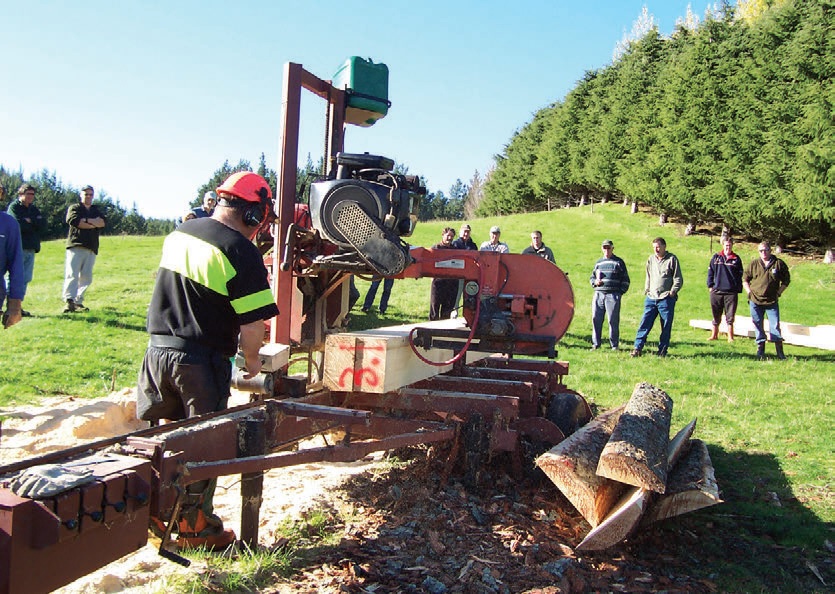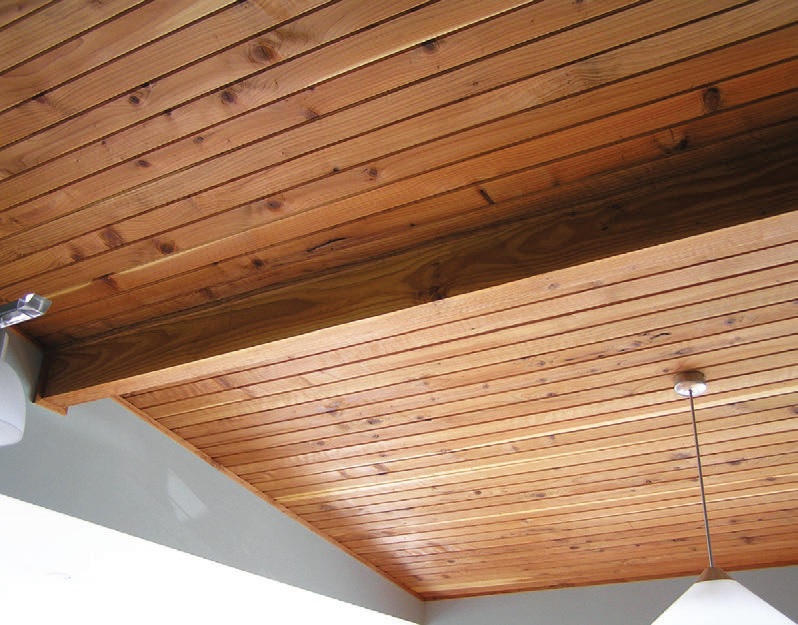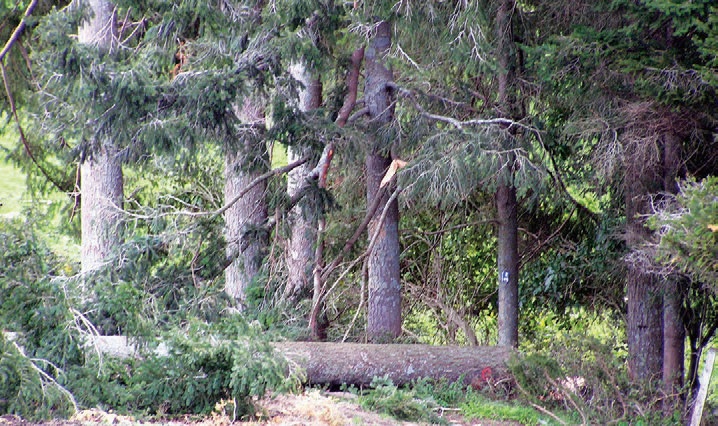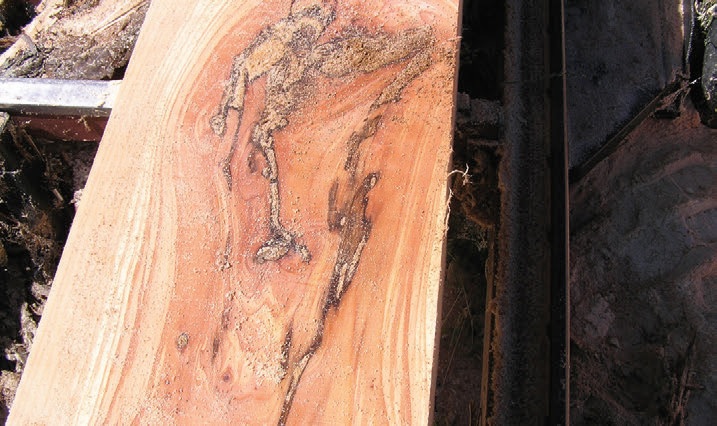A pet project
Mike Halliday, New Zealand Tree Grower May 2009.
It all started with a trip to Kuratau to spend a weekend with a cousin who had a bach there. We fell in love with the place and put an offer on a section. After some negotiation we ended up with the section and a set of plans for a house that the vendor had intended building there.
I had always hankered after the idea of one day having a house built from timber that I had milled from the farm. I had sold the farm and retained some cutting rights, so what better opportunity to make the dream a reality. The next step was to buy a portable mill. Not wanting to try and make a career of turning out huge volumes of timber and quickly becoming insolvent, I decided on a Woodmizer band-mill. This would be better for special purpose timbers because of the higher recovery rate. I found a second-hand one in the Manawatu, and set to teaching myself how to use it. Luckily it was almost fool-proof.
In the various woodlots and gorge plantings we had a variety of millable species to choose from, but the new building code limited us somewhat, requiring treated timber for all exterior framing and cladding. Thankfully there has been some later relaxation of this regarding macrocarpa for cladding, but we were stuck with treated radiata.
Selecting the timber
After much debate and thought, we settled on –
- Fifty-year-old radiata for exterior framing and for the board and batten cladding
- Douglas fir for interior framing and second storey floor joists
- Redwood sarking for the ceiling of the living area
- Himalayan cedar for the upstairs doors.

Originally we were going to use eucalypt for flooring, but as that seemed to be the ‘in’ timber of the moment, we decided to do something different.At that stage I was chairman of the Indigenous Forest Section of the NZFFA, and as such had become involved in a Sustainable Farming Fund project involving red beech. What better way to promote the sustainable use of indigenous timbers, we thought, than to have a staircase and floor built from them.
Luckily for us my cousin who lives in Kuratau is a builder of the old school, and likes taking on interesting projects. His advice was to use timber as a feature, and not to overdo it, something we had already taken on board when looking at other houses built by timber enthusiasts.
With a little tweaking, the inherited plans came up with something that we were more than happy to go ahead with. There were the normal hassles with the building permit, and the looming prospect of machine stress grading for structural timber. This made it difficult for portable millers to provide framing timber even for their own houses, so it was on to the radiata first.

Milling the radiata
The trees in question had been planted in 1956, on a gorge edge at the bottom of what was then the old airstrip, by Alan Elliot of the Patoka Timber Company fame. I had pruned some of them as a teenager after my father had met this bloke called Neil Barr, who recommended pruning and thinning. As you can imagine there were some reasonably big trees in there, but we only had to trim one butt down to fit it on the mill. Being what is now described as old crop radiata, there was a lot of heartwood in the butt logs and they were surprisingly light – light enough to be manoeuvred with log forks on a 65 hp tractor.
Once the milling began the learning started. For example making sure that logs were cut to the correct lengths needed for both framing and cladding, and that there was enough volume. I have to admit to dropping a couple of extra trees to find the correct length of log. We also ran short of a couple of the longest lengths of board and batten − bad measurement by the builder I say − so they had to come from ITM.
For the board and batten we cut 9x2's and 3x2's. You need to realise that Woodmizer is an American brand, so I had to re-learn imperial measurements and buy new imperial tools.
After drying, these boards were split with a band-saw and dressed on one side with grooves for air circulation. Unfortunately a wet winter saw us having to kiln dry this timber, and the framing warped during treatment to the extent that it was unusable. Fortunately there was a good deal going on some 120-year-old Douglas fir from the Rotorua area so that was used instead. Of course the leaky home thing had sent everyone into a panic and this timber had to be H1.2 treated for exterior walls. This is ironic as Douglas fir is naturally durable to H1.2 rating. It would never do to have anyone who knew anything about timber writing the building code.
Douglas fir
Next came the Douglas fir, trees that were planted in 1959 on the day that the British Lions played Taranaki, and once again pruned with youthful exuberance. I had found out fairly quickly about the wisdom of climbing up trees that naturally shed branches that I should prune my way down.

These trees were also planted on a gorge edge and required some coaxing with a wire rope to go in the right direction. The good thing about the trees is the fact that we could do a variation on a production thin by taking out crop trees and leaving the rest to grow on for another 20 or 30 years. One of the many things about the untimely death of Leith Knowles that really saddens me is that I was never able to show him the quality of the timber from these trees. He was never quite convinced of the merits of growing them in Patoka.
Redwood and deodar timber
The redwoods and deodars were part of one of our original Catchment Board plantings from the early 1960s. Only a couple of stems of each were required, so the rest can carry on doing their job for decades.The seed source of the redwoods was unknown, possibly the stock came from Wilson’s Nurseries in Hastings. They had very little done to them for 25 years until they were thinned and given a largely cosmetic pruning.
Not being in a particularly sheltered area, they were subject to wind damage as well as the attentions of possums. But the two felled in what could loosely be described as a production thinning managed to provide eight millable logs over four metres long, with the large end diameter of the tallest tree being 650 mm.

The timber itself is very soft cutting, and compared to Douglas fir, easy on gear, However it displays almost hardwood characteristics in sawing, with some internal checking from the second log up. One of the trees came from the outside of the block, and one from an inside row. Surprisingly it was this inside tree that provided the biggest disappointment as a result of a fungal infection from a pruning scar about seven metres up the tree. There was no outside evidence of this, apart from a slight mound on the exterior of the log.
Once dry the timber required quite an amount of picking over to get sufficient heartwood for the ceiling. The deodar was air dried, and only just made it down to the correct moisture content when required for making up the doors. It is a very resinous timber, and although a softwood, seems to take as long to dry as a hardwood does.
The building is not totally complete – there is some finishing work to do – but it is still very liveable, and the feature timbers look quite stunning.

 Farm Forestry New Zealand
Farm Forestry New Zealand

